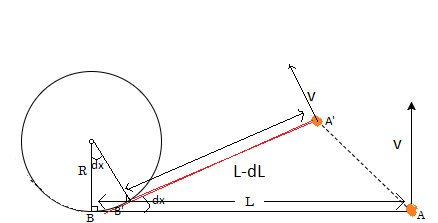Round about
A horizontal plane supports a stationary vertical cylinder of radius R and a disc A attached to the cylinder by a horizontal thread A B of length L (see figure above, top view). An initial velocity v is imparted to the disc, as shown above. How long will it move along the plane until it strikes against the cylinder?
Details and Assumptions:
- Neglect friction at all contact surfaces.
- Do not consider gravitational forces.
- The radius of the disc as compared to the radius of the cylinder is very small.
This section requires Javascript.
You are seeing this because something didn't load right. We suggest you, (a) try
refreshing the page, (b) enabling javascript if it is disabled on your browser and,
finally, (c)
loading the
non-javascript version of this page
. We're sorry about the hassle.
3 solutions
I Too did exactly the same way!
why is at any time instant the velocity of the particle perpendicular to the thread?
Log in to reply
Because one end of the thread is fixed and the thread is neither extending nor slacking. The only option left for the other end is to move perpendicular to the thread.

Careful observation will show that angular momentum is not conserved about any feasible point due to tension in thread.Also velocity will remain conserved because tension is perpendicular to motion of particle.
Let particle reach position A' in time dt.
Amount of thread wrapped = dL = R(dx) ⋯ ⋯ ⋯ ( # ) .
Now since time interval considered is very small,B'A'A is 'almost' a circular arc of radius = L-dL.
AA' =(L-dL)dx= v(dt)
Substituting value of dx from # ,
v(dt)=dL(L-dL)/R
Since dL times dL is veryy small,we will ignore it.
⟹ v d t = R L d L
⟹ v t = 2 R L 2
⟹ t = 2 v R L 2
Great solution! Thanks for the recommendation. Will post more problems in the future!
@Tapas Mazumdar Nice problem!
Keep posting more mechanics problems!
A better problem would have been the one in which the cylinder too rotates to conserve the angular momentum,here the cylinder's axis is fixed by external means which is exerting torque,but wouldn't it be nice if the cylinder too is free to rotate due to torque by the tension of the thread about its centre,a popular one this
Let the particle travels such that the thread wraps on the cylinder by an angle θ in time t.
At any time instant the velocity of the particle is perpendicular to the thread, hence it will not do any work on the particle and its kinetic energy and speed will remain constant.
After time t, the length of the thread which is not yet wrapped will be r = L − R θ .
Differentiating with respect to time, we get
d t d r = − R d t d θ
d θ = − R d r
The distance moved by the particle in further small time ‘dt’ will be v d t = r d θ
Replacing the value d θ = − R d r
v d t = − R r d r
v ∫ 0 t d t = − R 1 ∫ L 0 r d r t = 2 v R L 2